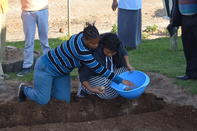
Use Quality Seed for Better Yields
Quality seeds are a fundamental requirement for good production. Home processed seed can also be of good quality if it is well processed, clean and stored dry.
Using quality seeds ensure a higher seedling emergence (usually above 85%), strong seedlings and a more uniform plant stand. Using good seeds can also ensure a faster growth rate and plants with better resistance to pests, diseases and drought. Quality seeds should be sourced from pest and disease-free plants.
They should be of uniform size, colour and shape and free of weed seeds and chaff. If seeds are very small, mix with soil or dry (well composted) manure. The ratio of seeds to manure varies depending on how densely you want to plant your crop.
Mix the seeds and soil very well and fill a 2-litre cooldrink bottle with the seed-soil mix. Make a hole in the bottle cap and sow in a straight line.
How to Sow Indigenous Crops
Stretch a piece of string between pegs to make straight, evenly spaced rows. The spacing between rows will depend on which crop you plant. Planting closer together can increase competition for sun and water, but for straggly plants, it means that there is better support to grow larger.
Wider spacing between plants will ensure more room for weeding and watering. When sowing, use a stick to make a furrow following along the string. Shake the seeds from the cooldrink bottle into this furrow and cover lightly with soil. Use fresh water to regularly irrigate your seeds.
How to Use Manure to Fertilise Indigenous Vegetables
All African indigenous vegetables need manure or fertilizers for vigorous growth. Strong-growing plants have resistance to pests and diseases and will produce high yields.
Farmyard manure such as cow, goat or chicken droppings are a low-cost alternative to inorganic chemical fertilizers and can help farmers to achieve higher yields. If a farmer has a kraal, it is an easy and cost-effective way to use animal manure to make compost to fertilise vegetable gardens.
How to make and apply farmyard manure: Collect animal dung from the kraal. Heap the dung in small, knee-height piles. It can be heaped directly in the garden during the dry season or it can be stored in a flat area closer to the kraal. Leave it to properly decompose as this will give the best results. Before applying the manure, mix it with soil.
How to Make Compost from Manure
Making compost from manure and working that into the soil, will increase your soil’s fertility and help provide nutrients for crops to grow stronger. To make compost, you will need dry materials such as straw, sorghum, maize, millet straws, bean, soybean and groundnut stems or even dried weeds.
You will also need green materials (weeds, hedge trimmings and vegetable peels) and animal waste such as cow dung, poultry litter, goat and sheep droppings.
To cover your compost you need topsoil, wood, plastic sheeting, carpet scraps or dry grass. You will also need water and a turn stick or spade.
Prepare a pit of reasonable depth. It can be any length depending on the amount of available materials. Lay twigs or chopped dry materials at the bottom. Add compost materials in layers, alternating moist and dry materials. Moist ingredients are things like food scraps, fruit, tea bags and seaweed.
Dry materials can include straw, leaves, sawdust and wood ash. Now, add manure, green manure (such as grass clippings) or any source of nitrogen. Cover with anything you have - wood, plastic sheeting, carpet scraps, topsoil, dry grass or straw to keep it moist, but not soaked and sodden. Water occasionally, or let the rain do the job. Turn every few days.
Give the pile a quick turn with a pitchfork or shovel. Once your compost pile is established, add new materials by mixing them in, rather than by adding them in layers. Mixing or turning the compost pile is key to aerating the composting materials and speeding the process to completion.
By African Soil Health Consortium training material